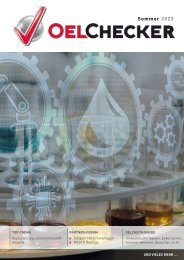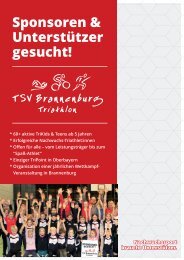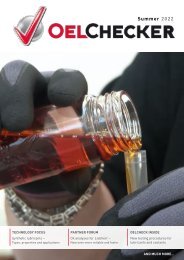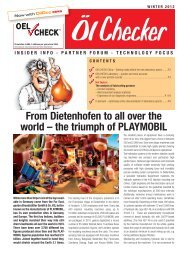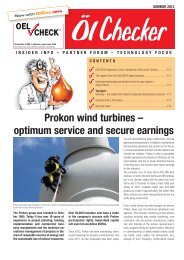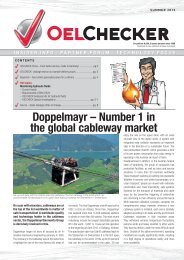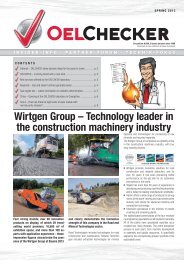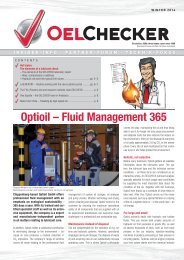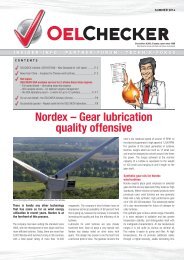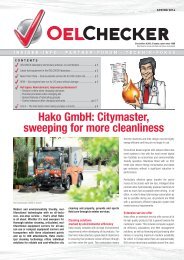OELCHECKER - Spring 2012
> Putzmeister - offering quality worldwide > Analysis kits and gas-tight sample bottles for refrigeration compressor oils > More playtime fun - thanks to OELCHECK! > 2012 customer survey results > The viscosity robot - the new OELCHECK laboratory assistant > Underground maintenance - K+S KALI GmbH workshops > Electrostatic discharges in hydraulic oils and lubricants > Question time: Could lengthy storage times have an influence on your oil samples? > and much more...
> Putzmeister - offering quality worldwide
> Analysis kits and gas-tight sample bottles for refrigeration compressor oils
> More playtime fun - thanks to OELCHECK!
> 2012 customer survey results
> The viscosity robot - the new OELCHECK laboratory assistant
> Underground maintenance - K+S KALI GmbH workshops
> Electrostatic discharges in hydraulic oils and lubricants
> Question time: Could lengthy storage times have an influence on your oil samples?
> and much more...
- No tags were found...
You also want an ePaper? Increase the reach of your titles
YUMPU automatically turns print PDFs into web optimized ePapers that Google loves.
OELCHECK PARTNER FORUM<br />
The K+S KALI GmbH maintenance engineers<br />
for the Hattorf/Wintershall mine<br />
use the pithead cage to get down to their<br />
enormous underground workshop. Their<br />
‚office‘ is 750 m under the Earth‘s surface.<br />
125 employees maintain and service the<br />
more than 1,000 machines currently in<br />
use in the mine. They operate round the<br />
clock using a three-shift system.<br />
K+S KALI GmbH is one of the world‘s leading<br />
potash mining companies. They specialise in the<br />
extraction and preparation of heterogeneous crude<br />
salts, particularly those containing magnesium.<br />
They are efficient and environmentally aware, and<br />
use a unique technology. As a supplier of speciality<br />
and standard fertilizers and products for industrial<br />
application, the company operates in all areas of<br />
life. The crude salts extracted underground, which<br />
all originate from the crystallisation of salty seawater,<br />
have different compositions depending on the<br />
deposits. Potash is mined in the Hattorf/Wintershall<br />
(HW) mine. Potassium, chemical symbol „K“,<br />
denotes, amongst other things, potassium-containing<br />
fertilizers for application in agriculture.<br />
The salt cannot be produced by synthetic means.<br />
As a fertilizer, it is essential for productive and<br />
healthy plant growth. Therefore, potassium fertilizers<br />
significantly help contribute to improving food<br />
supplies, both from a quantitative and qualitative<br />
perspective, for the world‘s growing population. In<br />
addition, diverse precursors for the production of<br />
industrial and pharmaceutical products originate<br />
from potassium.<br />
In order to extract the valuable raw material in the<br />
HW mine, holes up to 7 metres deep are dug in the<br />
relatively soft rock using special large-hole drilling<br />
Underground maintenance<br />
In the 20,000 m² workshop, the devices are serviced and repaired underground.<br />
K+S KALI GmbH workshops<br />
carriages. Due to blasting, the rock can loosen into<br />
the cavities produced as a result of the relatively<br />
thick drills. Large loaders transport the loosened<br />
rock to heavy crushers. They reduce the rock in<br />
size to fist-size pieces. These are then transported<br />
over kilometre-long belt conveyors to the shaft.<br />
Above ground, the rock is then further processed<br />
into high-quality fertilizers and industrial products.<br />
As with coal mining,<br />
an extensive<br />
ventilation system<br />
ensures a supply<br />
of fresh air to the<br />
mine. Used air and<br />
machine exhaust<br />
fumes are diverted<br />
via return air tunnels,<br />
which cannot<br />
be driven down. In<br />
the workshop, it is<br />
a pleasant 20°C<br />
to 28°C all year<br />
round. However,<br />
the air contains lots<br />
of fine salt particles. So corrosion and rust do not<br />
occur in the potash mine. The air is very dry and the<br />
metals do not corrode without water or moisture.<br />
However, things are very different if one of the devices<br />
has to go to the surface. Due to condensation,<br />
which develops on the relatively warm machine, it<br />
is immediately at risk on account of the accrued<br />
salt dust. This is one of the reasons why all maintenance<br />
and repair work is carried out underground<br />
where possible. What‘s more, relocating the vehicles<br />
is extremely time-consuming. They are carried<br />
through a transport shaft with a special goods lift.<br />
However, the lift can only take 20 tonnes at a time.<br />
Therefore, particularly large machines must be disassembled<br />
ready for transport beforehand.<br />
The workshop in the HW mine is enormous. The<br />
workspace and parking areas extend over an<br />
overall length of 480 m with a width of 25 m. The<br />
workshop‘s equipment is also impressive. Supported<br />
by a SAP system, the maintenance experts<br />
are responsible for servicing the 1,154 machines<br />
currently in operation. Whether loaders, large-hole<br />
drills, blast-hole drills or forklift trucks, they all need<br />
to be inspected in the workshop in accordance with<br />
strict specifications and, if necessary, repaired. On<br />
average, an assessment is required from the maintenance<br />
experts after every 300 hours of operation.<br />
OELCHECK lubricant analyses are part of their daily<br />
toolkit. The hydraulic oil of the large loaders is<br />
tested after every 500 hours of operation.<br />
The crude salt, loosened by blasting, is transported to the crushers<br />
using wheel loaders. K+S KALI GmbH produces 8 million tonnes of<br />
potash fertilizer in Germany per annum.<br />
Underground, only latest-generation, largecapacity<br />
loaders are used. Their hydraulic system<br />
works with approx. 700 litres of HLP hydraulic oil.<br />
The oil is changed depending on its condition and<br />
only then if the OELCHECK laboratory deems it<br />
necessary. As part of analysis kit 2, designed for<br />
oils from mobile hydraulics, wear metals (Fe, Cr,<br />
Cu, Pb, Al, Ni, Sn), additives (Ca, P, Zn, S) and any<br />
salt-containing impurities (K, Mg, Na) are identified.<br />
Particles are counted in seven size categories in accordance<br />
with ISO 4406 and SAE 4059. The general<br />
condition of the oil is assessed in terms of its<br />
viscosity at 40°C und 100°C, the viscosity index, IR<br />
oxidation, additive decomposition and appearance.<br />
The diagnosis engineers not only offer advice on oil<br />
change extensions but also suggest measures for<br />
improved servicing.<br />
As well as for guidance on condition-dependant oil<br />
changes, OELCHECK analyses are also used if the<br />
cause of damage to a device needs to be ascertained.<br />
Oil analytics have also proved invaluable in<br />
precautionary screening tests of the gears in the<br />
axles of all underground machines. Although the<br />
hypoid gear oil should still usually have wear protection<br />
reserves after a service life of 600 operating<br />
hours, it had already reached its limit in some<br />
cases. An immediate oil change, which was diagnosed<br />
for some gears, may have prevented more<br />
expensive damage. The maintenance engineers in<br />
the underground workshop have acquired invaluable<br />
knowledge about the work that they do thanks<br />
to the screening tests and OELCHECK lubricant<br />
analyses have once again proven their worth.





